Assessing the Capability of KELM Meta-Model Approach in Predicting the Energy Dissipation in Different Shapes Channels †
Abstract
1. Introduction
2. Materials and Methods
2.1. Used Data Sets
2.2. Kernel Extreme Learning Machine (KELM)
2.3. Artificial Neural Networks
2.4. Performance Criteria
3. Simulation and Models Development
3.1. Input Variables
3.2. KELM Parameters Setting
4. Results and Discussion
4.1. Results Obtained for Rectangular Shape Channels
4.2. Results Obtained for Trapezoidal Shape Channel
4.3. Validation of Proposed Best KELM Models Using ANN Method
5. Conclusions
Author Contributions
Funding
Conflicts of Interest
References
- Hager, W.H. Energy Dissipators & Hydraulic Jumps; Kluwer Academic Publication: Dordrecht, The Netherlands, 1992; pp. 151–173. [Google Scholar]
- Bhutto, H.; Mirani, S.; Chandio, S. Characteristics of free hydraulic jump in rectangular channel. Mehran Univ. Res. J. Eng. Technol. 1989, 8, 34–44. [Google Scholar]
- Finnemore, J.E.; Franzini, B.J. Fluid Mechanics with Engineering Applications; McGraw-Hill: New York, NY, USA, 2002; p. 790. [Google Scholar]
- Hager, W.H.; Bremen, R. 1989 Classical Hydraulic Jump: Sequent Depths. J. Hydraul. Res. 1989, 7, 565–585. [Google Scholar] [CrossRef]
- Ayanlar, K. Hydraulic Jump on Corrugated Beds. Master’s Thesis, Middle East Technical University, Department of Civil Engineering, Ankara, Turkey, 2004. [Google Scholar]
- Bilgin, A. Correlation and Distribution of Shear Stress for Turbulent Flow in a Smooth Rectangular Open Channel. J. Hydraul. Res. 2005, 43, 165–173. [Google Scholar] [CrossRef]
- Chang, C.K.; Azamathulla, H.M.; Zakaria, N.A.; Ghani, A.A. Appraisal of soft computing techniques in prediction of total bed material load in tropical rivers. J. Earth Syst. Sci. 2012, 121, 125–133. [Google Scholar] [CrossRef]
- Yan, J.; Jin, J.; Chen, F.; Yu, G.; Yin, H.; Wang, W. Urban flash flood forecast using support vector machine and numerical simulation. J. Hydroinform. 2018, 20, 221–231. [Google Scholar] [CrossRef]
- Kisi, O.; Shiri, J. Precipitation forecasting using wavelet-genetic programming and wavelet-neuro-fuzzy conjunction models. J. Water Resour. Manag. 2011, 25, 3135–3152. [Google Scholar] [CrossRef]
- Roushangar, K.; Alami, M.T.; Saghebian, S.M. Modeling open channel flow resistance with dune bedform via heuristic and nonlinear approaches. J. Hydroinform. 2018, 20, 356–375. [Google Scholar] [CrossRef]
- Azamathulla, H.M.; Ghani, A.A.; Leow, C.S.; Chang, C.K.; Zakaria, N.A. Gene-expression programming for the development of a stage-discharge curve of the Pahang River. J. Water Resour. Manag. 2011, 25, 2901–2916. [Google Scholar] [CrossRef]
- Roushangar, K.; Ghasempour, R. Estimation of bedload discharge in sewer pipes with different boundary conditions using an evolutionary algorithm. Int. J. Sediment Res. 2017, 32, 564–574. [Google Scholar] [CrossRef]
- Simsek, C. Forced Hydraulic Jump on Artificially Roughned Beds. Master’s Thesis, Middle East Technical University, Department of Civil Engineering, Ankara, Turkey, 2006. [Google Scholar]
- Evcimen, T.U. Effect of Prismatic Roughness on Hydraulic Jump in Trapezoidal Channels. Ph.D. Thesis, Middle East Technical University, Department of Civil Engineering, Ankara, Turkey, 2012. [Google Scholar]
- Huang, G.B.; Zhu, Q.Y.; Siew, C.K. Extreme learning machine: Theory and applications. Neurocomputing 2006, 70, 489–501. [Google Scholar] [CrossRef]
- Huang, G.B.; Zhou, H.; Ding, X.; Zhang, R. Extreme Learning Machine for Regression and Multiclass Classification. IEEE Trans. Syst. Man Cybern. Part B (Cybern.) 2012, 42, 513–529. [Google Scholar] [CrossRef] [PubMed]
- Haykin, S.; Cybenko, G. Approximation by Superposition of a Sigmoidal Function Neural Networks, 2nd ed.; Prentice Hall: Englewood Cliffs, NJ, USA, 1999; Volume 2, pp. 303–314. [Google Scholar]
- Rajaratnam, N.; Subramanya, K. Hydraulic Jump below Abrupt Symmetrical Expansions. J. Hydraul. Div. ASCE 1968, 94, 481–503. [Google Scholar]
- Hager, W.H. Hydraulic Jumps in Non-Prismatic Rectangular Channels. J. Hydraul. Res. 1985, 23, 21–35. [Google Scholar] [CrossRef]
- Gandhi, S. Characteristics of Hydraulic Jump. Int. J. Math. Comput. Phys. Electr. Comput. Eng. 2014, 8, 692–697. [Google Scholar]
- Wu, S.; Rajaratnam, N. Transition from hydraulic jump to open channel flow. J. Hydraul. Eng. 1996, 122, 526–528. [Google Scholar] [CrossRef]
- Elevatorski, E.A. Hydraulic Energy Dissipators; McGraw-Hill: New York, NY, USA, 2008. [Google Scholar]
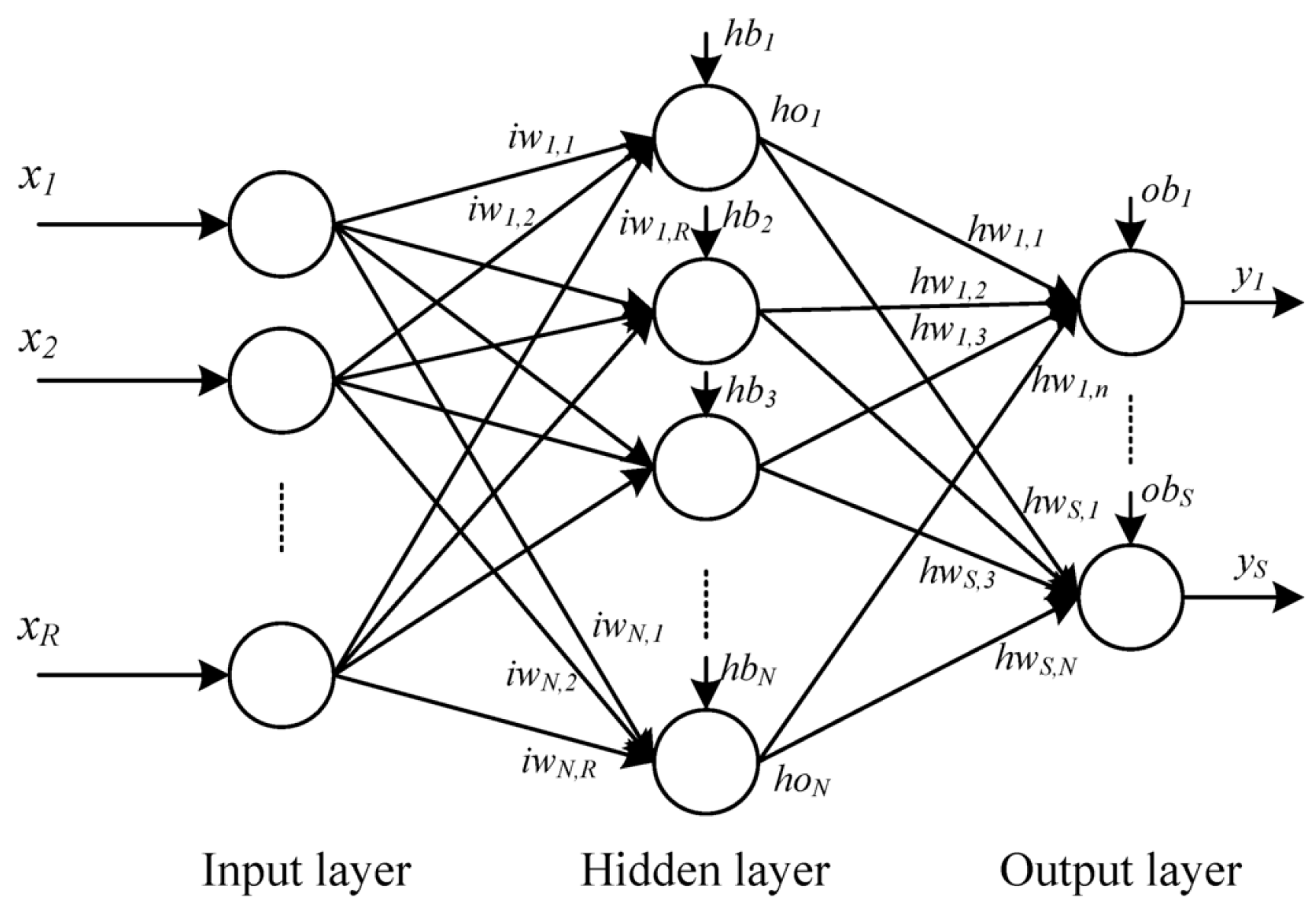
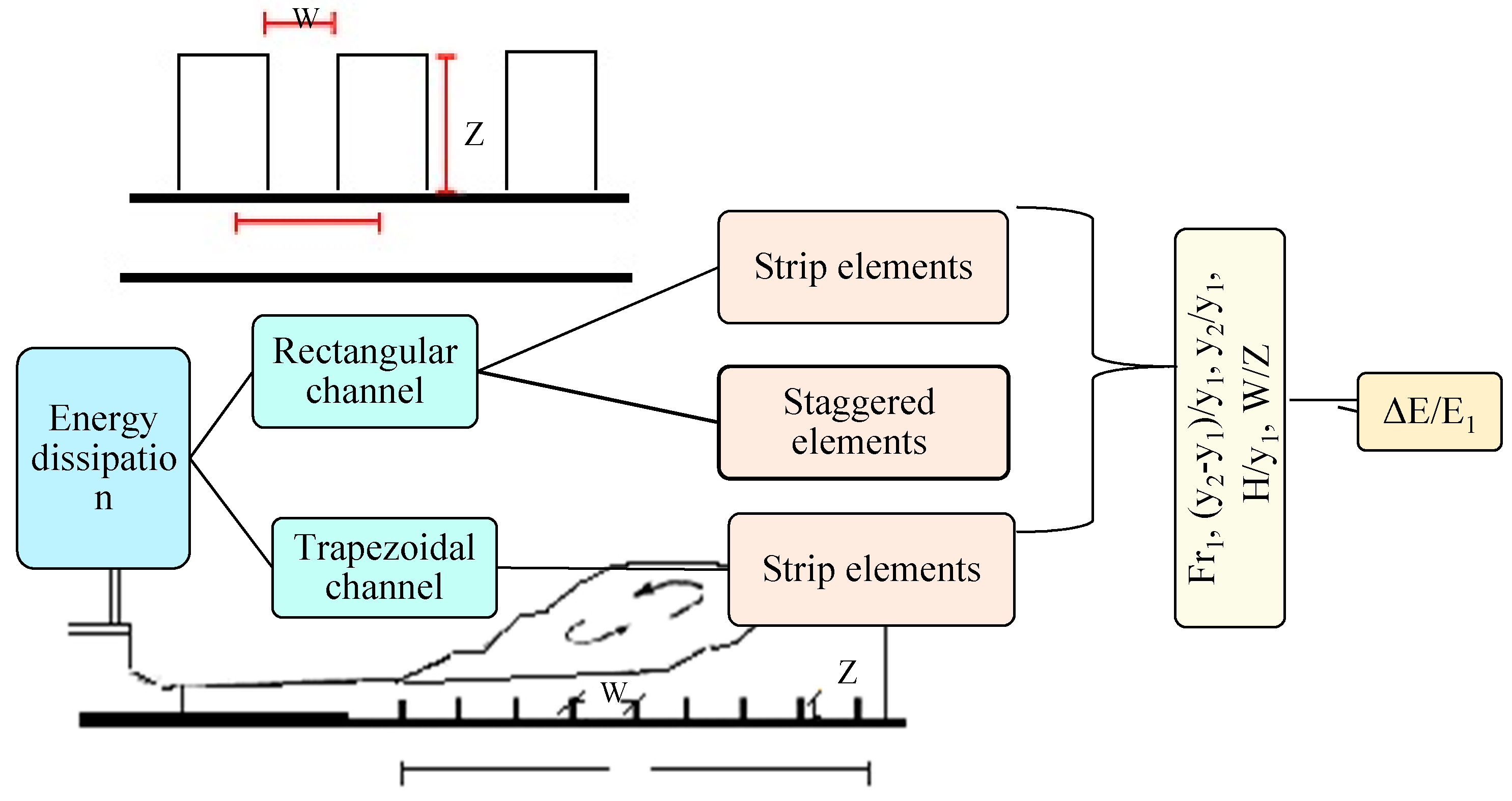
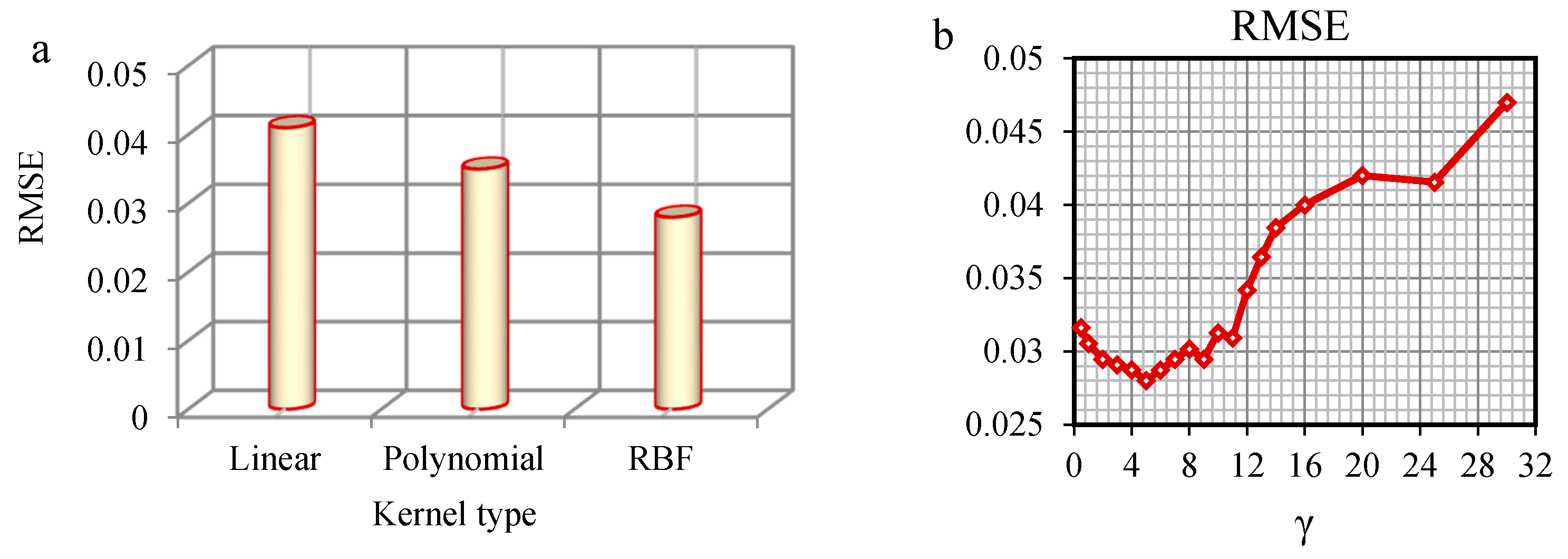
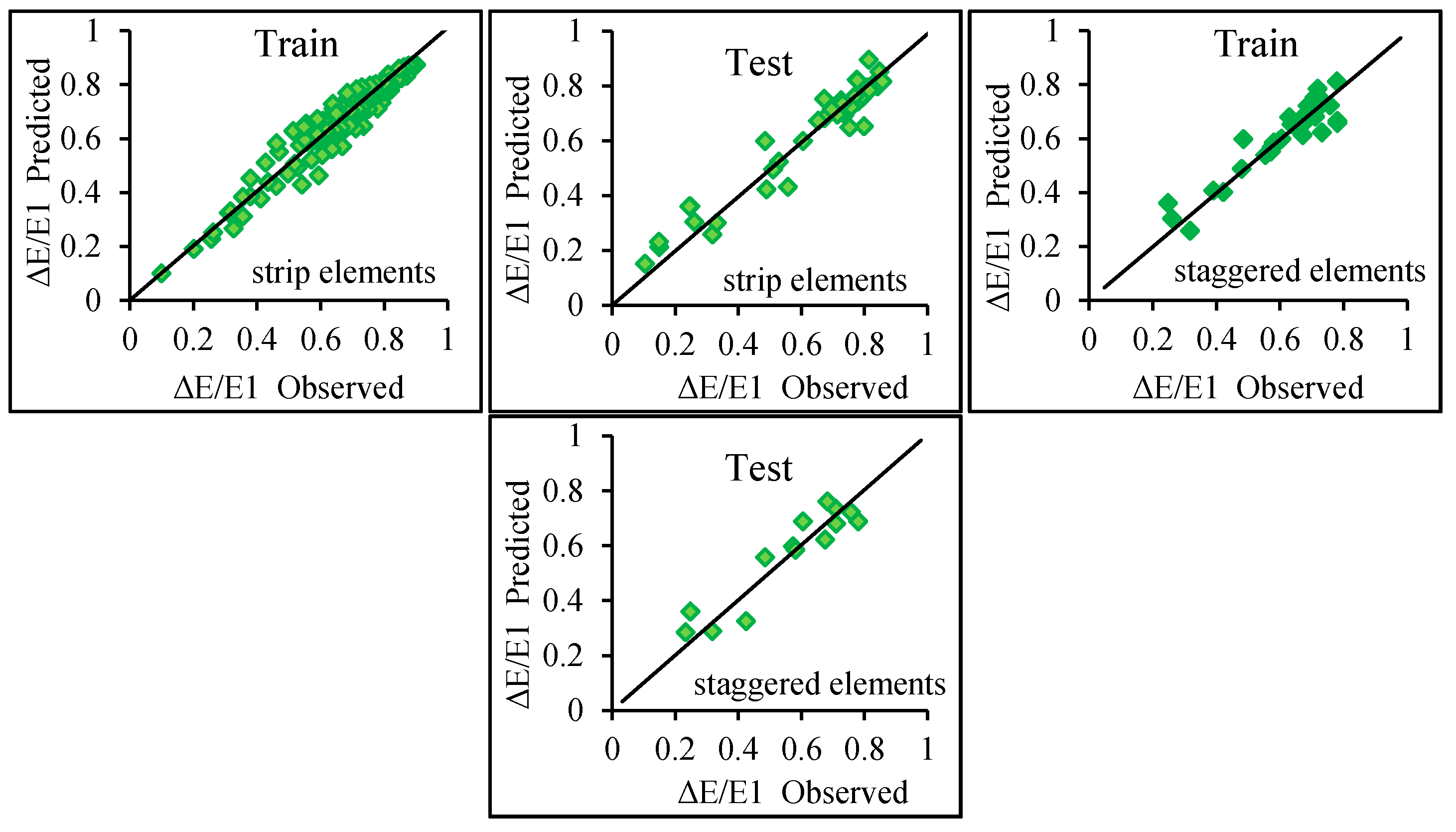
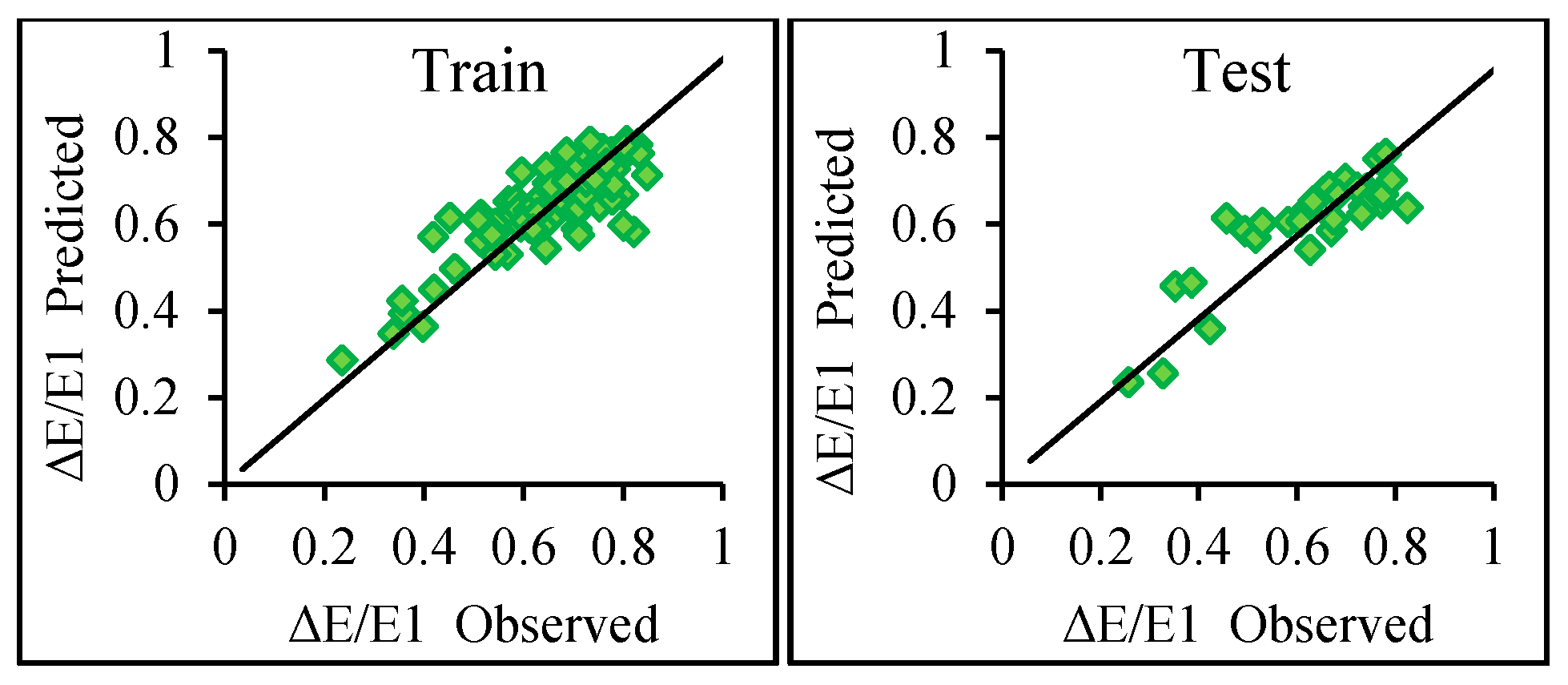
| Researcher | Channel Shape | Rough Element Arrangement | Fr1 (Froude Number) | W (cm) Space between Elements | Y Sequence Depth | Z (cm) Height of Elements |
|---|---|---|---|---|---|---|
| Simsik (2006) | Rectangular | Strip and staggered | 2.13–11.92 | 3–9 | 2.5–14.8 | 1 |
| Evcimen (2012) | Trapezoidal | Strip | 3.92–13.28 | 2–10 | 4.15–14.9 | 1–3 |
| Input Variable(s) | Models |
|---|---|
| Fr1 | M (I) |
| Fr1, (y2-y1)/y1 | M (II) |
| Fr1, Z/y1 | M (III) |
| Fr1, W/Z | M (IV) |
| Fr1, (y2-y1)/y1, W/Z | M (V) |
| Performance Criteria | Models | |||||
|---|---|---|---|---|---|---|
| Test | Train | |||||
| RMSE | DC | R | RMSE | DC | R | |
| Strip elements | ||||||
| 0.067 | 0.892 | 0.934 | 0.038 | 0.914 | 0.959 | M (I) |
| 0.055 | 0.942 | 0.982 | 0.032 | 0.968 | 0.983 | M (II) |
| 0.058 | 0.935 | 0.975 | 0.038 | 0.964 | 0.981 | M (III) |
| 0.062 | 0.922 | 0.973 | 0.039 | 0.963 | 0.978 | M (IV) |
| 0.049 | 0.944 | 0.986 | 0.025 | 0.973 | 0.991 | M (V) |
| Staggered elements | ||||||
| 0.075 | 0.818 | 0.841 | 0.043 | 0.859 | 0.863 | M (I) |
| 0.062 | 0.847 | 0.884 | 0.036 | 0.871 | 0.885 | M (II) |
| 0.065 | 0.842 | 0.878 | 0.043 | 0.868 | 0.883 | M (III) |
| 0.07 | 0.83 | 0.876 | 0.044 | 0.867 | 0.88 | M (IV) |
| 0.055 | 0.868 | 0.927 | 0.031 | 0.886 | 0.969 | M (V) |
| Performance Criteria | Models | |||||
|---|---|---|---|---|---|---|
| Test | Train | |||||
| RMSE | DC | R | RMSE | DC | R | |
| 0.086 | 0.804 | 0.904 | 0.072 | 0.822 | 0.909 | M (I) |
| 0.082 | 0.811 | 0.909 | 0.067 | 0.831 | 0.912 | M (II) |
| 0.084 | 0.809 | 0.906 | 0.069 | 0.825 | 0.91 | M (III) |
| 0.073 | 0.827 | 0.927 | 0.059 | 0.849 | 0.938 | M (IV) |
| 0.072 | 0.858 | 0.935 | 0.057 | 0.885 | 0.942 | M (V) |
| Structure of KELM and ANN | Performance Criteria | Models | |||||
|---|---|---|---|---|---|---|---|
| Test | Train | ||||||
| RMSE | DC | R | RMSE | DC | R | ||
| Rectangular shape channels with strip elements | |||||||
| γ = 5 | 0.049 | 0.944 | 0.986 | 0.025 | 0.973 | 0.991 | M (V), KELM |
| (3, 7, 1) * | 0.053 | 0.938 | 0.978 | 0.03 | 0.961 | 0.981 | M (V), ANN |
| Rectangular shape channels with staggered elements | |||||||
| γ = 4 | 0.055 | 0.868 | 0.927 | 0.031 | 0.886 | 0.969 | M (V), KELM |
| (3, 7, 1) | 0.061 | 0.851 | 0.915 | 0.035 | 0.87 | 0.935 | M (V), ANN |
| Trapezoidal shape channel | |||||||
| γ = 6 | 0.072 | 0.858 | 0.935 | 0.057 | 0.885 | 0.942 | M (V), KELM |
| (3, 9, 1) | 0.076 | 0.833 | 0.905 | 0.062 | 0.867 | 0.931 | M (V), ANN |
Publisher’s Note: MDPI stays neutral with regard to jurisdictional claims in published maps and institutional affiliations. |
© 2020 by the authors. Licensee MDPI, Basel, Switzerland. This article is an open access article distributed under the terms and conditions of the Creative Commons Attribution (CC BY) license (http://creativecommons.org/licenses/by/4.0/).
Share and Cite
Saghebian, S.M.; Dragomir-Stanciu, D.; Ghasempour, R. Assessing the Capability of KELM Meta-Model Approach in Predicting the Energy Dissipation in Different Shapes Channels. Proceedings 2020, 63, 45. https://doi.org/10.3390/proceedings2020063045
Saghebian SM, Dragomir-Stanciu D, Ghasempour R. Assessing the Capability of KELM Meta-Model Approach in Predicting the Energy Dissipation in Different Shapes Channels. Proceedings. 2020; 63(1):45. https://doi.org/10.3390/proceedings2020063045
Chicago/Turabian StyleSaghebian, Seyed Mahdi, Daniel Dragomir-Stanciu, and Roghayeh Ghasempour. 2020. "Assessing the Capability of KELM Meta-Model Approach in Predicting the Energy Dissipation in Different Shapes Channels" Proceedings 63, no. 1: 45. https://doi.org/10.3390/proceedings2020063045
APA StyleSaghebian, S. M., Dragomir-Stanciu, D., & Ghasempour, R. (2020). Assessing the Capability of KELM Meta-Model Approach in Predicting the Energy Dissipation in Different Shapes Channels. Proceedings, 63(1), 45. https://doi.org/10.3390/proceedings2020063045





